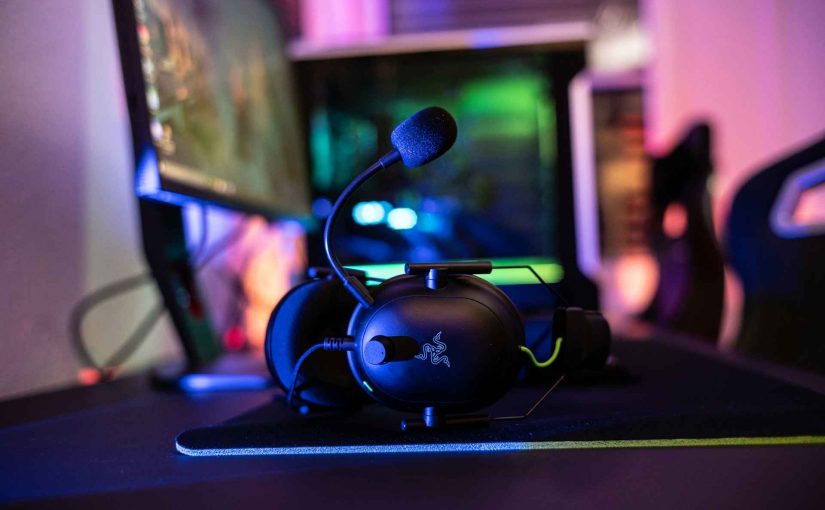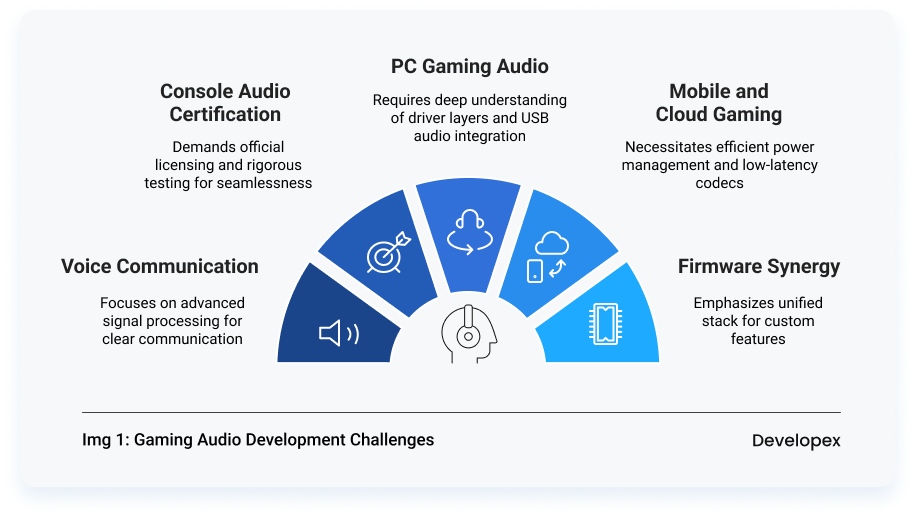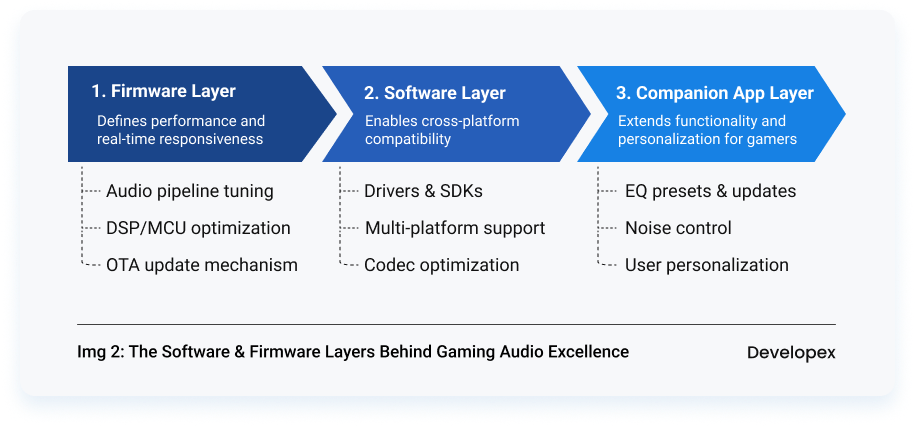
In modern gaming, “good” audio isn’t good enough. Players expect sound that not only immerses them but also gives them a competitive edge. In esports and fast-paced titles, milliseconds matter – the ability to detect subtle audio cues like footsteps, gun reloads, or directional movement can decide the outcome of a match.
At the same time, poor audio latency or desynchronized sound can break immersion and even cause motion sickness in VR or cloud gaming environments. That’s why low latency audio development and spatial audio implementation have become strategic priorities for gaming hardware brands.
The market for high-performance gaming headsets and custom gaming audio devices continues to expand, driven by the growth of competitive gaming, streaming, and cross-platform ecosystems. According to Grand View Research, the global gaming peripherals market (including audio devices) is projected to reach billions in the next few years, with strong demand for 3D audio for gaming, wireless gaming audio solutions, and AI-driven sound optimization.
Building a gaming audio device–whether it’s a custom gaming headset, console audio accessory, or wireless headphone for esports–requires a specialized engineering mindset.This deep dive explores the specialized technical considerations in the electronics and software stack required to succeed in custom gaming headset development.
- 1. Understanding the Gaming Audio Ecosystem
- 2. Key Technical Challenges and Design Priorities
- 3. Hardware and Component Considerations
- 4. Software and Firmware Integration: The Competitive Edge
- 5. User Experience & Design Considerations
- 6. Testing, Validation, and Certification: The Path to Market Readiness
- 7. Future Trends in Gaming Audio Devices
- Conclusion and The Developex Advantage
1. Understanding the Gaming Audio Ecosystem
Developing a gaming audio device requires more than high-quality speakers and stylish design – it’s about mastering a complex ecosystem where hardware, firmware, and software interact across multiple gaming platforms. From PC gaming headset development to console-compatible audio solutions and mobile gaming accessories, each environment brings its own technical and certification challenges.

1.1 The Multi-Platform Challenge
A single gaming audio product must often master multiple environments simultaneously. This demands robust multi-platform gaming audio compatibility and specialized engineering for each domain:
- PC Gaming Audio Optimization: This domain requires a deep understanding of driver layers (ASIO, WASAPI, etc.) and low-level USB audio class gaming integration to bypass system latency buffers.
- Console Audio Certification: To achieve true seamlessness on a PlayStation 5 or Xbox Series X, official licensing and rigorous console audio certification are mandatory. This involves highly specific Xbox licensed audio development or specialized PlayStation compatible headset development protocols.
- Mobile and Cloud Gaming: This necessitates efficient power management and often leverages specialized low-latency codecs like aptX low latency development or LC3 for reliable wireless gaming audio solutions.
1.2 Software–Hardware Synergy: Firmware is King
The physical hardware is only as good as the firmware running on it. Success in gaming headset firmware development hinges on treating the firmware, audio DSP for gaming devices, and host drivers as one unified stack. This tight synchronization allows manufacturers to execute crucial features like custom EQ presets and noise reduction directly on the device’s main chip. Achieving this requires specialized custom audio DSP development expertise.
1.3 Voice Communication & Streaming
The microphone is as vital as the speakers. Effective gaming microphone development goes far beyond acoustic quality, requiring advanced signal processing: dedicated gaming microphone noise cancellation, echo cancellation, and precision beamforming technology. The device also needs seamless integration with in-game communication platforms and external streaming software. Successful gaming audio SDK integration ensures the device interacts flawlessly with popular game engines (like Unity and Unreal) and chat clients.
2. Key Technical Challenges and Design Priorities
The most challenging aspects of gaming audio device development are all rooted in overcoming physical and computational constraints in real-time.
2.1. Achieving Ultra-Low Latency Audio Processing
In the world of esports audio equipment, where reaction times are measured in fractions of a second, the definition of “acceptable” latency is aggressive and unforgiving. While $\mathbf{20\ ms}$ or less is the non-negotiable standard for competitive play (matching wired performance), the true esports ideal is sub-$\mathbf{15\ ms}$ for virtually undetectable delay.
To achieve this, the industry relies on a careful balance between wired and wireless. Dedicated proprietary 2.4 GHz protocols (often implemented via a custom USB dongle) still offer the lowest, most reliable, and most stable wireless gaming audio solutions, often achieving sub-10ms performance. Although Bluetooth LE Audio and its LC3 codec promise advancements, the dedicated 2.4 GHz link currently reigns supreme for performance-critical scenarios.
The engineering task for low latency audio development is a bottom-up challenge. The firmware must run on a streamlined Real-Time Operating System (RTOS), managing I/O, wireless transmission, and DSP execution with predictable, low-jitter performance. Aggressive management of buffering for error correction is vital, as this buffer is often the single largest contributor to detrimental delay.
| Latency Target | Gaming Scenario | Preferred Connection Method | Rationale |
| < 15 ms | Competitive/Esports | Wired or Proprietary 2.4 GHz | Near-instant feedback for critical tactical advantage. |
| 20-40 ms | Casual/Immersive | Bluetooth LE Audio (LC3) / aptX LL | Acceptable for most casual play, minimal sync issues. |
| > 80 ms | Unacceptable | Standard Bluetooth (SBC/AAC) | Causes noticeable audio-visual lag, degrades competitive performance. |
2.2. Engineering Spatial and Positional Audio
3D audio for gaming is the essential feature for tactical awareness. High-quality binaural audio rendering relies heavily on HRTF implementation gaming (Head-Related Transfer Function), the mathematical model that replicates how a user’s anatomy affects sound waves. Devices must not only support but also be meticulously tuned for major industry standards like Dolby Atmos gaming implementation, DTS:X, and proprietary ecosystems such as Windows Sonic and PlayStation Tempest 3D.
The challenge is two-fold: Compute Load and Accuracy. The computation for HRTF processing is enormous, typically requiring a powerful, dedicated custom audio DSP development solution to prevent adding latency. Furthermore, using non-personalized, or generic, HRTFs often leads to diminished localization accuracy. To truly develop spatial audio for games, the system must involve an optimized HRTF set that delivers crystal-clear vertical and horizontal spatial cues, a critical factor in object-based audio gaming.
2.3. Mastering Voice Communication and Noise Suppression
Crystal-clear command is essential for team success. A gaming microphone development solution must be engineered to isolate the user’s voice under high-intensity, noisy conditions.
The current frontier in next-gen gaming audio solutions is the integration of machine learning. AI gaming audio enhancement leverages dedicated processors to run sophisticated algorithms, reliably distinguishing human speech from background noise. This machine learning audio optimization gaming system uses a multi-element beamforming array to create a focused acoustic zone, providing effective gaming microphone noise cancellation in real-time. This demands an Integrated A.I. Noise Filtration Processor within the headset itself.
3. Hardware and Component Considerations
The choice of components underpins the entire project, directly affecting cost, performance, and the ability to meet the sub-20ms latency target. While software defines flexibility, hardware defines fidelity. Successful custom gaming headset development requires balancing low distortion, computational power, and battery efficiency in a single cohesive package.
| Component Category | Key Gaming Design Priority | Critical Metric/Spec |
| Acoustic Drivers | Transient Speed & Positional Clarity | Low THD audio testing gaming (Total Harmonic Distortion) |
| Audio DSP Chips | Computational Power for HRTF/AI Noise | MIPS/Core clock vs. Power Consumption |
| Wireless Module | Stability and Latency | Proprietary 2.4 GHz FHSS implementation |
| Power Management | Runtime at Max Volume/DSP Load | Battery Capacity & Thermal Dissipation |
3.1 Acoustic and Driver Design
The physical drivers are the heart of any gaming headphone, defining gaming headset acoustic design. Competitive players expect clear mid-range for communication and detailed highs for environmental cues. Audio hardware engineering must prioritize dynamic or planar drivers engineered for an ultra-fast transient response to ensure immediate and accurate spatial cues. Beyond fidelity, tuning the impedance and sensitivity is critical for consistent performance across all platforms (PC, console, mobile) without requiring excessive power.
3.2 DSP Chips and Processing Power
Choosing the right audio DSP for gaming devices is critical. The decision to go with a custom vs off-the-shelf gaming audio solution often hinges on whether the chip can handle simultaneous, low-latency processing of both complex audio features and AI-driven voice enhancement. Multi-core DSPs are required for processing object-based audio formats (Dolby Atmos, DTS:X, Tempest 3D) while simultaneously running AI-based adaptive gaming audio technology for noise reduction. This dedicated hardware acceleration prevents the introduction of perceptible delay and conserves battery life.
3.3 Wireless Modules and Power Management
The rise of wireless gaming audio solutions introduces a strict requirement for wireless gaming headset development–to balance ultra-low latency with reliable link stability. Dedicated proprietary 2.4 GHz modules must prioritize Frequency Hopping Spread Spectrum (FHSS) implementation and antenna diversity to minimize interference, especially in crowded tournament environments. Furthermore, continuous, high-performance gaming sessions require careful battery and thermal management. This involves using low-power DSPs and SoCs and designing efficient thermal paths within the mechanical chassis to prevent overheating and ensure the device remains comfortable for long marathon sessions.
4. Software and Firmware Integration: The Competitive Edge
While hardware defines the foundation of a gaming audio device, its real personality comes from software and firmware. These layers control how the headset processes sound, communicates with platforms, and evolves through updates. For modern manufacturers, strong expertise in gaming headset software development services and firmware optimization is what differentiates an average device from a competitive one.

4.1 The Low-Level Pipeline Efficiency
The entire performance profile of a device is dictated by its gaming headset firmware development. We specialize in creating optimized, low-level code for the audio pipeline, developing on-device EQs, noise gates, and mic-monitoring directly on the DSP/MCU. This process requires precise audio engine synchronization, ensuring the internal clock, sample rate, and buffering align perfectly with the host platform’s audio engine. Furthermore, developing stable gaming audio firmware OTA updates ensures the system can be reliably improved and maintained post-launch, allowing manufacturers to deploy new machine learning audio optimization gaming algorithms post-release.
4.2 Mastering Cross-Platform Compatibility
Achieving true multi-platform gaming audio support means more than just having the right connectors; it requires specialized audio software development for gaming that handles diverse operating system audio models. This includes developing robust custom drivers for PC gaming audio optimization and, crucially, deep integration with proprietary console audio SDKs.
Cross-Platform Firmware Focus Areas:
- PC: Low-level USB audio class gaming integration and stability for APIs like ASIO/WASAPI.
- Console: Strict adherence to proprietary SDKs for features like PlayStation Tempest 3D and mandatory console audio certification.
- Wireless: Optimizing codecs like LC3 and aptX low latency development for seamless wireless gaming audio solutions.
Our expertise ensures the headset correctly processes object-based audio gaming data, passing stringent multi-platform gaming audio compatibility and certification tests.
4.3 Companion Apps and Unified User Experience
The companion application is now a required layer for modern gaming peripherals development. It serves as the portal for user personalization and device longevity. We integrate seamless OTA update modules with secure delivery protocols, custom EQ presets (e.g., competitive, cinematic), and advanced controls for features like gaming microphone noise cancellation. This is vital for unlocking the full potential of the device and enhancing brand loyalty.
5. User Experience & Design Considerations
Even the most advanced gaming audio device can fail if it’s uncomfortable, unintuitive, or visually unappealing. For brands investing in custom gaming headset development, user experience (UX) and industrial design are just as critical as acoustics or firmware. A great gaming headset feels invisible during long sessions, sounds natural across genres, and looks like part of the gamer’s setup.
5.1 Comfort and Ergonomics Engineering
The gaming headset comfort engineering process is crucial because competitive gamers often wear headsets for six hours or more. Poor design causes fatigue and pressure points. Engineering for comfort requires utilizing advanced material science–carefully selecting lightweight materials with high heat dissipation–and designing for mechanical durability. This goes hand-in-hand with precise tuning of the clamping force and weight distribution for extended marathon sessions, ensuring the device remains reliable even under the most prolonged use.
5.2 Tactical Sound Signature Tuning
A single “good” signature is insufficient. The most effective gaming audio device design offers switchable EQ profiles to meet the user’s tactical needs, a feature achieved through specialized custom audio DSP development and firmware tuning.
| Profile Type | Target User | Primary Goal | Implementation Focus |
| Competitive Mode | Esports / FPS Gamers | Positional Cue Enhancement | Emphasized mid-range, reduced distracting bass. |
| Immersive Mode | Casual / RPG Players | Wide Soundstage / Cinematic Feel | Enhanced bass and dynamic range, spatial DSP. |
| Balanced Mode | Mixed-Use Audience | Natural Tone & Consistency | Neutral firmware curve, minimal post-processing. |
The “Competitive” profile is a highly engineered equalization curve that specifically focuses on mid-range frequencies to enhance crucial in-game cues, such as the sound of footsteps and distant reloads–a key part of PC gaming audio optimization.
5.3 Aesthetic, Branding, and Inclusivity
Visual design strongly influences purchasing decisions in the gaming market. A well-executed gaming audio device design blends ergonomics, durability, and aesthetics by integrating brand-specific elements like controllable RGB zones and using high-quality materials (e.g., premium metals, reinforced plastics).
Furthermore, modern gaming peripherals development requires a focus on inclusive design. Devices must accommodate users with different needs, utilizing features such as adjustable hearing profiles, support for mono audio modes, and clear visual indicators for mute and battery status. This blend of technical precision and UX excellence ensures the headset appeals to the broadest possible market while reflecting brand responsibility.
6. Testing, Validation, and Certification: The Path to Market Readiness
Delivering a reliable, competitive product requires rigorous gaming audio device testing and mandatory certification. This process confirms that the custom gaming headset performs consistently across platforms, meets global safety standards, and provides the low-latency, high-fidelity experience demanded by competitive players.
6.1 Rigorous Audio Performance Validation
Laboratory testing is essential to confirm the headset meets its promised specifications. We move beyond simple quality checks to perform competitive-grade validation, utilizing high-level metrics crucial for esports audio equipment.
| Metric | Purpose | Competitive Standard | Engineering Validation |
| End-to-End Latency | Competitive Response & VR Comfort | <20 ms (Wired/2.4 GHz) | Measures total signal input-to-output delay. |
| THD/SNR | Audio Fidelity & Clarity | THD <1% at high volume / SNR >90 dB | Confirms minimal distortion and clear output. |
| Spatial Accuracy | Positional Advantage | Flawless Directional Cues | HRTF implementation and 3D audio for gaming validation. |
6.2 Compatibility and Real-World Stress Testing
A product is only ready when it proves resilient under duress. The testing workflow must go far beyond the lab to confirm multi-platform gaming audio compatibility and mechanical resilience.
- Cross-Platform QA: Ensures seamless operation and consistent latency across PC, PlayStation, Xbox, and mobile, confirming correct implementation of console-specific protocols (Xbox licensed audio development, PlayStation compatible headset certification).
- Firmware Reliability: Validation includes testing gaming audio firmware OTA updates reliability in simulated real-world conditions.
- Mechanical Durability: Headsets are subjected to drop tests, stress tests on critical joints (headbands/hinges), and environmental tests to guarantee a long product lifespan, a key component of gaming peripherals development.
6.3 Mandatory Regulatory and Platform Certification
To reach global markets, gaming audio device certification is non-negotiable. Early planning for compliance is critical to avoid costly redesigns and launch delays.
- Global Regulatory Compliance: Adherence to FCC, CE, RoHS, and REACH is mandatory for electrical and environmental safety and market access in North America and the EU.
- Wireless and Codec Licensing: Devices require certification from the Bluetooth SIG and official licensing for high-performance codecs like aptX low latency development.
- Platform Approvals: Successful entry into console markets requires passing strict console audio certification tests and obtaining official licensing for proprietary spatial standards (e.g., Dolby Atmos, Tempest 3D).
By integrating these testing and compliance phases into the gaming audio development lifecycle, manufacturers can confidently release high-performance, durable, and globally compliant products.
7. Future Trends in Gaming Audio Devices
The evolution of gaming peripherals development is accelerating, driven by the convergence of Artificial Intelligence (AI), personalized biometrics, and the expansion of spatial computing platforms like VR/AR. The future of custom gaming headset development will not just be about reacting to sound, but anticipating it.
7.1 AI-Driven Adaptive and Personalized Audio
The biggest shift is the integration of machine learning directly into the audio stack. This development moves beyond static EQ presets to real-time, context-aware sound processing.
- AI-driven Adaptive Audio: Future headsets will use on-device machine learning models to automatically recognize in-game environments or scenarios (e.g., detecting a noisy firefight vs. a stealth sequence). This AI gaming audio enhancement will dynamically adjust the EQ, compression, and noise gates in real-time to highlight crucial cues or suppress non-essential sound. This is the foundation of next-gen gaming audio solutions.
- Personalized HRTF (Head-Related Transfer Function): For true spatial accuracy in VR gaming audio development and competitive titles, generic 3D audio is insufficient. The next generation will leverage machine learning and biometric input (like a simple phone photo of the user’s ear) to synthesize a highly accurate, personalized HRTF implementation. This will eliminate front-back confusion and dramatically improve localization, making the soundscape perfectly calibrated to the individual listener.
7.2 Haptics, Biometrics, and Ecosystem Integration
Gaming audio devices are becoming sensors that monitor the user and the environment, leading to deeper immersion and control.
- Haptic Audio Integration: Devices will integrate haptic feedback to translate low-frequency sound elements (like explosions) into physical sensations on the headset or controllers. This adds a critical layer of immersion, especially for cinematic and object-based audio gaming.
- Biometric Monitoring: Headsets are emerging as sophisticated trackers, with embedded sensors monitoring stress levels or heart rates during intense gameplay. This data can be used by the adaptive gaming audio technology to automatically adjust noise suppression or music volume to optimize player focus.
- Sustainability: Driven by consumer demand, the industry is seeing a clear trend toward manufacturing using recycled materials and implementing smaller, more efficient battery cells to reduce environmental impact without sacrificing the long runtime needed for marathon sessions.
7.3 The Cloud Gaming Latency Challenge
As cloud gaming platforms grow, they introduce a significant new layer of latency beyond the local hardware and wireless link. This total latency (network + encoding/decoding + audio processing) presents a major challenge to the sub-20ms standard. The industry is responding through advanced network protocols, Bluetooth LE Audio (LC3) for efficiency, and smarter buffering algorithms to ensure the wireless gaming audio solutions can deliver a high-quality experience even over the long-distance network links required by cloud services.
The future of gaming audio device development lies in this intelligent convergence, delivering a system that is not only ultra-fast and precise but also uniquely tailored to the individual player.
Conclusion and The Developex Advantage
Building high-performance gaming audio devices requires more than excellent hardware – it demands expertise across software, firmware, and hardware engineering. From custom gaming headset development to gaming audio device design, manufacturers face complex challenges: achieving low latency, delivering accurate spatial audio, ensuring multi-platform compatibility, and meeting rigorous certification requirements.
Developex bridges this gap by offering end-to-end gaming audio engineering services. Our team specializes in optimizing the entire audio pipeline, from MCU and DSP selection to driver and middleware integration, ensuring that every device meets the demanding standards of competitive gaming.
Key advantages of partnering with Developex:
- Comprehensive Audio Expertise: Hardware, firmware, and companion apps all engineered in concert.
- Performance Optimization: Focus on low-latency audio development, 3D spatial rendering, and high-fidelity sound.
- Cross-Platform Compatibility: Devices designed for PC, console, mobile, and cloud gaming.
- Future-Ready Solutions: Incorporating AI-driven audio enhancement, adaptive DSP, and haptic integration.
By combining deep technical expertise with user-centered design, Developex helps manufacturers build gaming audio products that are reliable, immersive, and ready for the competitive gaming market.
Whether you are looking to outsource gaming audio software development, optimize firmware for spatial audio devices, or launch custom gaming audio solutions for manufacturers, Developex provides the technical expertise and engineering infrastructure to deliver premium, high-performance, and market-ready audio experiences.
Let’s discuss your next breakthrough audio product.





